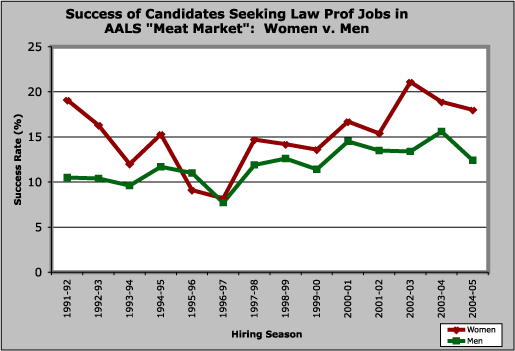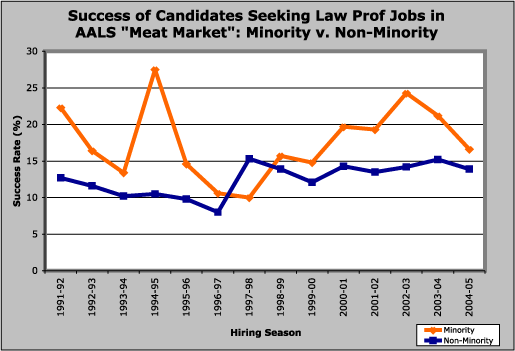Some Positive Signs
Prof. Jeffrey Harrison of the University of Florida College of Law asked almost exactly a year ago whether Race, Class and Diversity adversely affects the possibility of tenure for minorities in law.
Prof. Tom W. Bell of Chapman University School of Law responded soon after, providing some refreshing data from the American Association of Law Schools’ (AALS) report, Statistical Report on Law School Faculty and Candidates for Law Faculty Positions (2005-06).
(Although the data is American, there are no comparable figures in Canada).
This chart, using data from Table 13B of the Statistical Report, shows how well women have fared relative to men at landing jobs via the AALS faculty recruitment process:

This chart, using data from Table 13C, shows how well minorities have fared relative to non-minorities:

He then cites the data in Table 13E:
| Candidate Type | Success Rate (%) |
| Minority Women | 18.5 |
| Minority Men | 17.5 |
| Non-Minority Women | 15.0 |
| Non-Minority Men | 11.3 |
Overall, it would appear as if minorities are not discriminated and may even have an advantage in the application process.
The Rest of the Picture
Christine Garton, former student at the University of Pennsylvania Law School, provides an alternate interpretation in the Legal Times,
According to the Association of American Law Schools Statistical Report on Law School Faculty for 2002-2003, fully tenured female law professors make up 25.2 percent of law faculties nationwide and 34.2 percent of the total law faculty count. That’s certainly progress from the 13 percent of female law school professors in 1991. But with that rate of growth — roughly 1 percent a year — it will take another 25 years for women to reach the 50-percent mark.
The trend in recent years of law schools hiring more contract and adjunct faculty has another interesting side-effect: an over-representation of women in non-tenured staff.
Ann Farmer describes this process in The Rocky Road to the Ivory Tower as creating a “pink ghetto.”
She quotes Laura T. Kessler, associate professor at the S.J. Quinney College
of Law at the University of Utah, who describes two types of professors in law:
Good Jobs:
- tenured or tenure-track
- deans, full professors, associate professors, and assistant professors
- prestige, good salaries, job security, power, and greater autonomy
Less Desirable Jobs:
- nontenure-track, contractual positions
- full-time legal writing instructors, clinical professors, and academic support
- lower salaries, less security, less prestige, and less overall job trimmings
Farmer cites statistics that seem to demonstrate that women are disproportionately found in what would be considered “less desirable jobs”:
- 25% of tenured full professors
- 46% of tenure-track assistant professors
- 66% of lecturers and instructors
- 54% of associate deans without professional titles
- 68% of assistant deans without professional titles
 Kessler says,
Kessler says,
When you look around the room, you see that the ones who don’t get to vote are disproportionately female.
If this is true, minorities may still be getting the job, but not the right kinds. They may also be most susceptible to another trend in legal academia, lateral hiring, when in-house opportunities fail to avail themselves.
Jessie of UCLA Law shares her thoughts on Ms. JD,
Women are filling labor intensive posts in law schools as writing professors and clinical instructors, without the eventual rewards of security and prestige that tenure promises.
… I think this data confirms some negative truths about academic legal hiring: as a women approaching a competitive job market my gender is a blessing only if I exploit it to my advantage by distinguishing myself not just with my work but with my gender.

Garton also quotes Lisa Lerman, a Catholic University Law Professor, on other hiring factors,
Some of the faculty members on the faculty appointments committee are buddies with judges. Instead of looking to the conference for new hires, they’ll ask these judges who are ‘good academic material’ — meaning those that are serving as clerks. In the end, women are at a significant disadvantage because it’s a documented fact that fewer women attain these prestigious clerkships. More and more women are coming into the process without knowing anyone.
Class more important than Race or Gender?
But Harrison complicates the situation even further. He asks whether class-ism is a more important distinguishing factor than race or gender,
…the elitists who control legal education have little interest in actual contact with the world outside their own. White and African American candidates who attended elite schools; can drop the right names; have educated parents; are able to discuss the best restaurants in L.A., New York or Boston; and who can pass a political litmus test will he hired over an African American candidate who cannot check off everything on this list. In seeking diversity the search is on for what seems to be the least diverse candidates possible.
If so, any diversity that does exist would appear superficial; adequate to demonstrate physical inclusiveness, but failing to incorporate divergent perspectives and viewpoints from a broad strata of society.

Hello. my name is joshua woods and i am a sophmore student working on my senior project. The topic that i have chosen is “Lawyers” because this is a career that i intend to pursue. I am seeking a graph showing the statistical information of how many law students apply law school and how many result in a scuccessful career. The information here was not useful however i was hoping that maybe you would be able to aid me in my search. Thank you very much. Josh
Law is Cool:
Josh, assuming you are in Canada, the easiest way is to probably go to the respective law school websites and look at their application and admission statistics and make the table yourself.
If you’re in Ontario, a lot of this information is centralized and available via OLSAS.
If you do collect this information about Canadian schools please do share it with us and we will consider posting it on the site.